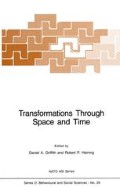Abstract
This paper provides a brief exposition of the direct equilibrium approach and related attraction-regulated dynamics, as applied to a spatial production and exchange economy. The approach is specified as direct because after introduction of utility functions in price-quantity space, economic equilibrium is established by appeal to the individual rationality principle without the intermediary of market demand functions. The type of dynamics adequate to this direct equilibrium approach was introduced by Dejon and Graef (1983), and by Dejon (1983), at the San Miniato NATO Institute entitled ‘Evolving Geographical Structures,’ as attraction—regulated dynamics. The so-called passive attraction-regulated form of migration laws is particularly suited to revealing the relationship that exists between a direct equilibrium and stationarity.
Access this chapter
Tax calculation will be finalised at checkout
Purchases are for personal use only
Preview
Unable to display preview. Download preview PDF.
References
Allen, P., M. Sanglier and G. Engelen, 1984, Chance and Necessity in Urban Systems, in Stochastic Phenomena and Chaotic Behaviour in Complex Systems, edited by P. Schuster, Berlin: Springer-Verlag, pp. 231–249.
Alonso, W., 1964, Location and Land Use, Cambridge, Mass.: Harvard University Press.
Benassy, J.-P., 1982, The Economics of Market Disequilibrium. New York: Academic Press.
Dejon, B., 1983, Attraction-regulated Dynamic Equilibrium Models of Migration of a Multiplicative Type, in Evolving Geographical Structures, edited by D. Griffith and A. Lea, The Hague: Martinus Nijhoff, pp. 12–23.
Dejon, B., and F. Graef, 1983, Eine Klasse von Modellen zur Beschreibung von Staedtischen Agglomerations-und Deglomerationsprozessen, in Stadt, Region, Land, edited by P. Maeeke, Rheinisch-Westfaelische TH Aachen: Institut fuer Stadtbauwesen, pp. 32–38.
Dejon, B., and B. Gueldner, 1985, Dynamics of Wide-sense Migrational Systems: A Choice-theoretic Approach, Papers of the Regional Science Association, 55: 121–133.
Dejon, B., and B. Gueldner, and G. Wenzel, 1985a, The Structure of Direct Equilibrium, unpublished manuscript, Institute of Applied Mathematics, University of Erlangen-Nuernberg.
Dejon, B., and B. Gueldner, and G. Wenzel, 1985b, On Stochastic Equilibrium with Price Dispersion, in Proceedings of the 10th Symposium on Operations Research, edited by M. Beckmann, K.-W. Gaede, K. Ritter and H. Schneeweiss, Munich, August 26–28.
Gueldner, B., 1984, Attraktivitaetsgesteuerte Dynamische AIternativenwahlmodelle: Analysen und Simulationen in drei Anwendungsbereichen, unpublished doctoral dissertation, Institute of Applied Mathematics, University of Erlangen-Nuernberg.
Hildenbrand, W., 1971, Random Preferences and Equilibrium Analysis, Journal of Economic Theory, 3: 414–429.
Leonardi, G., 1983, An Optimal Control Representation of a Stochastic Multistage-multiactor Choice Process, in Evolving Geographical Structures, edited by D. Griffith and A. Lea, The Hague: Martinus Nijhoff, pp. 62–72.
McFadden, D., 1978, Modelling the Choice of Residential Location, in Spatial Interaction Theory and Planning Models, edited by L. Lundqvist, F. Snickars and J. Weibull, Amsterdam: North-Holland, pp. 75–96.
Papageorgiou, Y., 1979, Agglomeration, Regional Science and Urban Economics, 9: 41–59.
Rogerson, P., 1983, The Effects of Job Search and Competition on Unemployment and Vacancies in Regional Labor Markets, in Evolving Geographical Structures, edited by D. Griffith and A. Lea, The Hague: Martinus Nijhoff, pp. 349–371.
Author information
Authors and Affiliations
Editor information
Editors and Affiliations
Rights and permissions
Copyright information
© 1986 Martinus Nijhoff Publishers, Dordrecht
About this chapter
Cite this chapter
Dejon, B. (1986). Modelling an Economy in Space and Time: The Direct Equilibrium Approach With Attraction-Regulated Dynamics. In: Griffith, D.A., Haining, R.P. (eds) Transformations Through Space and Time. NATO ASI Series, vol 29. Springer, Dordrecht. https://doi.org/10.1007/978-94-009-4430-5_12
Download citation
DOI: https://doi.org/10.1007/978-94-009-4430-5_12
Publisher Name: Springer, Dordrecht
Print ISBN: 978-94-010-8472-7
Online ISBN: 978-94-009-4430-5
eBook Packages: Springer Book Archive

